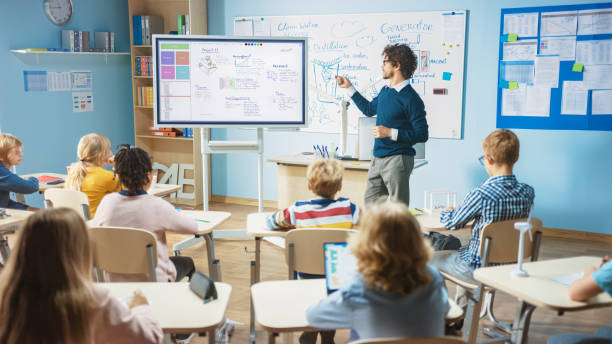Improve Your Child’s Performance with Primary Science Tuition Singapore
Improve Your Child’s Performance with Primary Science Tuition Singapore
Blog Article
A Comprehensive Guide to the Different Discovering Techniques in Key Science Instruction
The expedition of diverse understanding methods in primary science instruction offers a chance for instructors to improve student engagement and understanding substantially. By taking a look at hands-on understanding strategies, inquiry-based approaches, and joint approaches, we can identify effective techniques that satisfy various discovering styles. Additionally, the combination of innovation and differentiated direction plays a crucial role in fostering a comprehensive environment. Nonetheless, the question continues to be: how can these techniques be successfully applied in the classroom to maximize their impact? The answer depends on a closer assessment of each method and its implications for teaching science.

Hands-On Knowing Techniques
Hands-on discovering strategies play a crucial function in key scientific research direction, involving students in active expedition and trial and error. These approaches enable students to connect straight with phenomena and materials, cultivating a much deeper understanding of scientific ideas. By using manipulatives, designs, and real-life experiments, teachers develop an atmosphere where trainees can observe, hypothesize, and examine their concepts.
Such strategies not just enhance understanding but also cultivate vital thinking and problem-solving abilities. When pupils get involved in activities like constructing straightforward machines, growing seeds, or conducting chemical responses, they are urged to ask questions and seek solutions via their own observations. This experiential strategy aids to debunk intricate scientific concepts, making them much more relatable and accessible.
Furthermore, hands-on discovering promotes partnership amongst peers, as trainees commonly operate in groups to conduct experiments or share searchings for. This teamwork not just enriches their discovering experience yet also develops vital social skills. Eventually, integrating hands-on methods in main scientific research guideline cultivates a long-lasting love of discovering and interest concerning the all-natural world, laying a strong structure for future scholastic searches in science and beyond.
Inquiry-Based Discovering
Inquiry-based knowing is an educational technique that motivates pupils to ask concerns, explore phenomena, and construct their very own understanding of scientific concepts. This technique moves the focus from standard teacher-led instruction to an extra student-centered experience, where learners take the effort in their academic trip. By promoting curiosity, inquiry-based discovering promotes much deeper interaction with the product, allowing trainees to discover topics in a meaningful context.
In method, this method often entails hands-on experiments, observations, and essential reasoning tasks that align closely with the scientific technique. Pupils are encouraged to create hypotheses, layout examinations, and assess data, which grows vital skills such as logical and analytic thinking. The function of the educator in this structure is to help with exploration, guiding students through the questions process while urging independent thought and cooperation.
In addition, inquiry-based knowing supports a sense of ownership over the learning process, inspiring pupils to pursue understanding proactively. This technique not only improves understanding of scientific ideas but likewise fosters a lifelong love for knowing, outfitting students with the skills required to navigate a significantly complicated world.
Collaborative Learning Approaches
Collective discovering strategies encourage pupils to take part in significant communications with peers, fostering a shared duty for their instructional results. In primary scientific research guideline, these methods encourage learners to interact to discover scientific ideas, address issues, and conduct experiments (primary science tuition Singapore). By taking part in team activities, pupils can take advantage of diverse point of views, permitting richer understanding and retention of clinical understanding
One secret aspect of collective discovering is the focus on interaction abilities. Pupils must express their ideas, pay attention actively to others, and work out ideas, every one of which are vital proficiencies in both real-world and scholastic contexts. This social interaction not just boosts their understanding of scientific concepts however likewise promotes teamwork and conflict additional reading resolution skills.
In addition, collaborative learning frequently brings about enhanced inspiration and engagement. When pupils see the value of their contributions within a team, they are most likely to take possession of their knowing trip. Educators can facilitate this procedure by making organized team jobs that line up with educational program objectives while providing assistance on efficient cooperation methods. Generally, including collective understanding approaches in key science guideline cultivates a dynamic discovering environment that prepares students for future scholastic and social obstacles.
Modern Technology Assimilation in Scientific Research
The assimilation of modern technology in key science instruction boosts finding out experiences by supplying cutting-edge devices and resources that sustain numerous training methods, consisting of joint learning - primary science tuition Singapore. Using electronic systems, simulations, and interactive applications allows pupils to involve deeply with scientific principles, promoting a much more hands-on method to understanding
Online labs, as an example, make it possible for students to perform experiments safely and efficiently, promoting inquiry-based knowing. These devices can imitate real-world scientific situations, permitting students to envision complex processes that would certainly be challenging to replicate in a traditional class setup. Innovation fosters interaction and cooperation amongst students, as they can share findings and function together on jobs via online platforms.
Furthermore, multimedia presentations and educational video clips can enhance lessons by satisfying varied knowing styles, making abstract principles extra easily accessible. Data analysis devices also empower trainees to gather and analyze clinical information, reinforcing important assuming skills. Generally, the strategic consolidation of modern technology in main scientific research direction not only enhances interaction however additionally prepares pupils for a highly sophisticated culture, outfitting them with vital abilities for future scientific undertakings.
Differentiated Instruction Strategies
Set apart direction methods are crucial for addressing the diverse demands of students in primary science education. These approaches make it possible for teachers to tailor their teaching approaches to accommodate differing capabilities, interests, and discovering designs within the class. By employing set apart instruction, educators can develop a comprehensive setting check my source that fosters involvement and enhances understanding of clinical ideas.
One efficient approach is to use flexible organizing, which permits trainees to team up with peers at comparable skill degrees or with differing viewpoints. This technique urges peer understanding and advertises important thinking. Additionally, offering options in jobs can encourage trainees, permitting them to select jobs that reverberate with their interests while still meeting curricular purposes.
In addition, integrating tiered tasks is one more important method. By developing tasks with varying degrees of complexity, educators can ensure that all students are suitably tested, no matter of their proficiency. Utilizing formative assessments to determine comprehending further allows instructors to adjust their instructional methods dynamically, guaranteeing that each learner receives the assistance they require.
Inevitably, applying separated direction techniques in primary science education and learning not only enhances pupil learning end results yet additionally grows a passion for science, preparing students for future academic quests.

Conclusion
In summary, efficient key scientific research direction requires a multifaceted approach that incorporates hands-on discovering, inquiry-based techniques, and collective techniques. The integration of modern technology and set apart direction better caters to varied understanding designs, fostering an atmosphere favorable to exploration and critical reasoning.
The expedition of varied knowing methods in key scientific research instruction presents a chance for educators to enhance pupil engagement and understanding substantially.Hands-on understanding strategies play a pivotal role in key science direction, engaging trainees in energetic exploration and testing.Inquiry-based discovering is a training approach that motivates trainees to ask questions, investigate phenomena, and create their very own use this link understanding of clinical ideas.Joint understanding strategies encourage trainees to engage in purposeful interactions with peers, promoting a common obligation for their academic outcomes. On the whole, including collaborative learning methods in key science direction grows a dynamic knowing atmosphere that prepares students for future scholastic and social obstacles.
Report this page